
Doctors used augmented reality and a robot to carry out incredibly complicated surgery that would otherwise have been impossible.
A 25-year-old man was taken to the emergency room of Jerusalem’s Shaare Zedek Medical Center (SZMC) after being seriously injured in a fall at his workplace. The trauma team diagnosed an unstable spine fracture that put the man at immediate risk of permanent paralysis.
“After assessing the patient, Dr. Cezar Mizrahi, a neurosurgeon at the hospital’s spine surgery department, thought the patient could benefit from a new technological advancement: a robot-guided, augmented-reality-assisted imaging of the fractured spine,” reports the Jerusalem Post:
The patient became the first in the world to undergo a procedure using augmented reality (AR) to repair an unstable spinal fracture. The operation involved AR-assistance guided by a surgical spine robot, allowing the team to apply surgical screws in an extremely precise fashion along the spinal column.
AR is an interactive experience that enhances the real world with computer-generated perceptual information. Using software, apps, and hardware such as special glasses, AR overlays digital content onto real-life environments and objects. This enriches the user experience and turns the immediate surroundings into an interactive learning environment that is revolutionizing the way companies manufacture, improve and distribute their products. It makes it possible for industrial users to “become one” with the systems and machines with which they work and to optimize and augment with human ingenuity, observation, and creativity.
AR works by superimposing digital information onto real-world objects to create a 3D experience that allows users to interact with both the physical and digital worlds, but it can’t and doesn’t exist alone…An AR-enabled device with a camera such as smart glasses, a tablet, or a smartphone parses a video feed to identify a physical object or the environment around the user, such as a piece of machinery or the layout of a warehouse. A 3D digital replica of the object in the cloud connects the real and virtual environments and collects information from the physical object and digital. The AR device then downloads information about the object from the cloud and superimposes digital information over the object using markers or trackers like GPS, accelerometers, orientation and barometric sensors, and more. This creates a part-real, part-digital 3D interface.
“Bringing together AR and robotics in this minimally invasive technique had never been performed in surgery anywhere in the world,” said Mizrahi after the successful operation. “To our great joy, this combination of those new innovations was to the direct benefit of this patient and the overall healthcare improvement for the people of Jerusalem and beyond.
The experience of performing surgery equipped with an AR headset felt like being a combat pilot,” he recalled. “I had all the patient’s vital information, including the CT images, displayed directly in front of me. I could look one way and see the lineup of the surgical screws that I had planned out before the procedure and then look down and see the surgical field magnified. The experience helped me perform the procedure exactly as I planned it, and only make adjustments that I might have felt necessary as the surgery developed.”
Robotics is fueling other life-saving innovations. Doctors recently did the first robotic liver transplant in America. Robots can fit in small spaces in people’s bodies that a surgeon can’t reach without cutting through living tissue, or doing other collateral damage.
Robot waiters are now proliferating in restaurants in South Korea.
Medicine is advancing in other ways as well. A woman who was previously unable to have children recently received her sister’s womb in the first womb transplant in England. Artificial intelligence is now developing highly-effective antibodies to fight disease. Doctors overseas are using artificial intelligence to detect cases of breast cancer more effectively.
Scientists recently developed a treatment for alcoholism that reduces drinking by 90% among the lab monkeys it was tested on.
In other news, scientists recently discovered a metal that can heal itself, which could lead to an engineering revolution.



